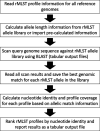Ribosomal MLST nucleotide identity (rMLST-NI), a rapid bacterial species identification method: application to Klebsiella and Raoultella genomic species validation
- PMID: 36098501
- PMCID: PMC9676034
- DOI: 10.1099/mgen.0.000849
Ribosomal MLST nucleotide identity (rMLST-NI), a rapid bacterial species identification method: application to Klebsiella and Raoultella genomic species validation
Abstract
Bacterial genomics is making an increasing contribution to the fields of medicine and public health microbiology. Consequently, accurate species identification of bacterial genomes is an important task, particularly as the number of genomes stored in online databases increases rapidly and new species are frequently discovered. Existing database entries require regular re-evaluation to ensure that species annotations are consistent with the latest species definitions. We have developed an automated method for bacterial species identification that is an extension of ribosomal multilocus sequence typing (rMLST). The method calculates an 'rMLST nucleotide identity' (rMLST-NI) based on the nucleotides present in the protein-encoding ribosomal genes derived from bacterial genomes. rMLST-NI was used to validate the species annotations of 11839 publicly available Klebsiella and Raoultella genomes based on a comparison with a library of type strain genomes. rMLST-NI was compared with two whole-genome average nucleotide identity methods (OrthoANIu and FastANI) and the k-mer based Kleborate software. The results of the four methods agreed across a dataset of 11839 bacterial genomes and identified a small number of entries (n=89) with species annotations that required updating. The rMLST-NI method was 3.5 times faster than Kleborate, 4.5 times faster than FastANI and 1600 times faster than OrthoANIu. rMLST-NI represents a fast and generic method for species identification using type strains as a reference.
Keywords: Klebsiella; Raoultella; bacterial genomes; bacterial species identification; nucleotide identity; rMLST.
Conflict of interest statement
The authors declare that there are no conflicts of interest.
Figures





Similar articles
-
Ribosomal multilocus sequence typing: universal characterization of bacteria from domain to strain.Microbiology (Reading). 2012 Apr;158(Pt 4):1005-1015. doi: 10.1099/mic.0.055459-0. Epub 2012 Jan 27. Microbiology (Reading). 2012. PMID: 22282518 Free PMC article.
-
Using multilocus sequence typing to study bacterial variation: prospects in the genomic era.Future Microbiol. 2014;9(5):623-30. doi: 10.2217/fmb.14.24. Future Microbiol. 2014. PMID: 24957089
-
Benchmarking of methods for genomic taxonomy.J Clin Microbiol. 2014 May;52(5):1529-39. doi: 10.1128/JCM.02981-13. Epub 2014 Feb 26. J Clin Microbiol. 2014. PMID: 24574292 Free PMC article.
-
FastANI, Mash and Dashing equally differentiate between Klebsiella species.PeerJ. 2022 Jul 21;10:e13784. doi: 10.7717/peerj.13784. eCollection 2022. PeerJ. 2022. PMID: 35891643 Free PMC article.
-
Genomic identification of nitrogen-fixing Klebsiella variicola, K. pneumoniae and K. quasipneumoniae.J Basic Microbiol. 2016 Jan;56(1):78-84. doi: 10.1002/jobm.201500415. Epub 2015 Oct 16. J Basic Microbiol. 2016. PMID: 26471769
Cited by
-
Rapid identification of enteric bacteria from whole genome sequences using average nucleotide identity metrics.Front Microbiol. 2023 Dec 14;14:1225207. doi: 10.3389/fmicb.2023.1225207. eCollection 2023. Front Microbiol. 2023. PMID: 38156000 Free PMC article.
-
De novo assembly and comparative genome analysis for polyhydroxyalkanoates-producing Bacillus sp. BNPI-92 strain.J Genet Eng Biotechnol. 2023 Nov 22;21(1):132. doi: 10.1186/s43141-023-00578-7. J Genet Eng Biotechnol. 2023. PMID: 37991636 Free PMC article.
-
Complexities in species identification for Serratia marcescens complex for the modern microbiology laboratory.Microbiol Spectr. 2025 Jan 7;13(1):e0136124. doi: 10.1128/spectrum.01361-24. Epub 2024 Dec 9. Microbiol Spectr. 2025. PMID: 39651858 Free PMC article. No abstract available.
-
Two novel Raoultella species associated with bleeding cankers of broadleaf hosts, Raoultella scottia sp. nov. and Raoultella lignicola sp. nov.Front Microbiol. 2024 May 2;15:1386923. doi: 10.3389/fmicb.2024.1386923. eCollection 2024. Front Microbiol. 2024. PMID: 38756725 Free PMC article.
References
Publication types
MeSH terms
Substances
Grants and funding
LinkOut - more resources
Full Text Sources
Molecular Biology Databases
Miscellaneous

